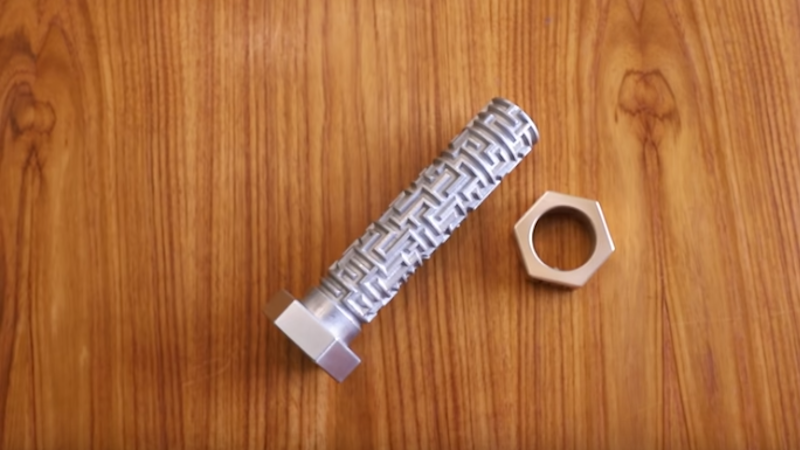Maze bolts, a bolt which has a maze along its shaft traversed by a pin on its nut, are great fun. Here’s a really beautiful metal version by [Robinson Foundry], made by a process more makers should know about – lost PLA casting.
His basic method is to 3D print in PLA, and then use more or less the same process as lost wax casting.
He 3D printed the part, along with the sprues and risers that go along with casting, in PLA, then dipped the parts in slurry ten (10) times. He heated in a kiln to 500°F (260°C), the PLA melted and ran out or burned away. With the PLA gone, after repairing a few cracks, he raised the temperature to 1500°F (815°C) and vitrified the slurry into a ceramic. He now had molds.
The nut is bronze. The bolt is aluminum. He poured the metal with the molds hot, held in heated sand, so the metal can flow into all the small details. The rest of the project is just cleanup, but we learned that you can vary the finish produced by glass bead blasting just by varying the air pressure.
A great demo of a useful technique and a fun toy at the end.
We covered a great technique for doing lost PLA casting using a microwave.
















Very cool…
People complain about torx or pentalobe being “anti tamper” bolts manufacturers use to prevent us repairing stuff… this is a whole new (and beautiful!) level…
i used a slurry of “durabond 90” ,drywall compound,its refractory
at least up to bronze melting temp,used borax washing powder
from the grocery store as flux,and a stainless steel pot as a crucible in a coal forge
surprised that the wax industry isnt making products for printing,
as waxes are used for a variety of purposes and are engineered with very specific properties and melting points
https://3dinsider.com/wax-3d-printing/
I think he is using pla because it is at about 1/3 the cost of these specialty filaments.
https://www.amazon.com/Polymaker-PolyCast-Filament-Designed-Investment/dp/B07J678V8C/ref=sr_1_3?crid=1TWV07HMQMTQE&keywords=PolyMaker%2BPolyCast%2BFilament&qid=1651832692&s=industrial&sprefix=polymaker%2Bpolycast%2Bfilament%2Cindustrial%2C100&sr=1-3&th=1
There are 3d printable wax filaments. I’ve found them hard to print and less dimensionally accurate than PLA, and PLA burns out so nicely it’s hard to justify messing about with wax.
Have you tried slurry/shell casting with the durabond? My experiences with this have been lots of cracking of the mold because of the thin shell. I’m having more luck with full investment casting the way jewelers traditionally do.
I like the level of detail he gets, he’s one of the better casters on YouTube. It looks like the magic treatment is a couple layers of plain suspendaslurry for the fine detail, then sand and slurry, then wire to prevent cracking.
One of the best I’ve seen as well. I think this is a good starting point for any beginner.
This is very neat. Start manufacturing..now! lol